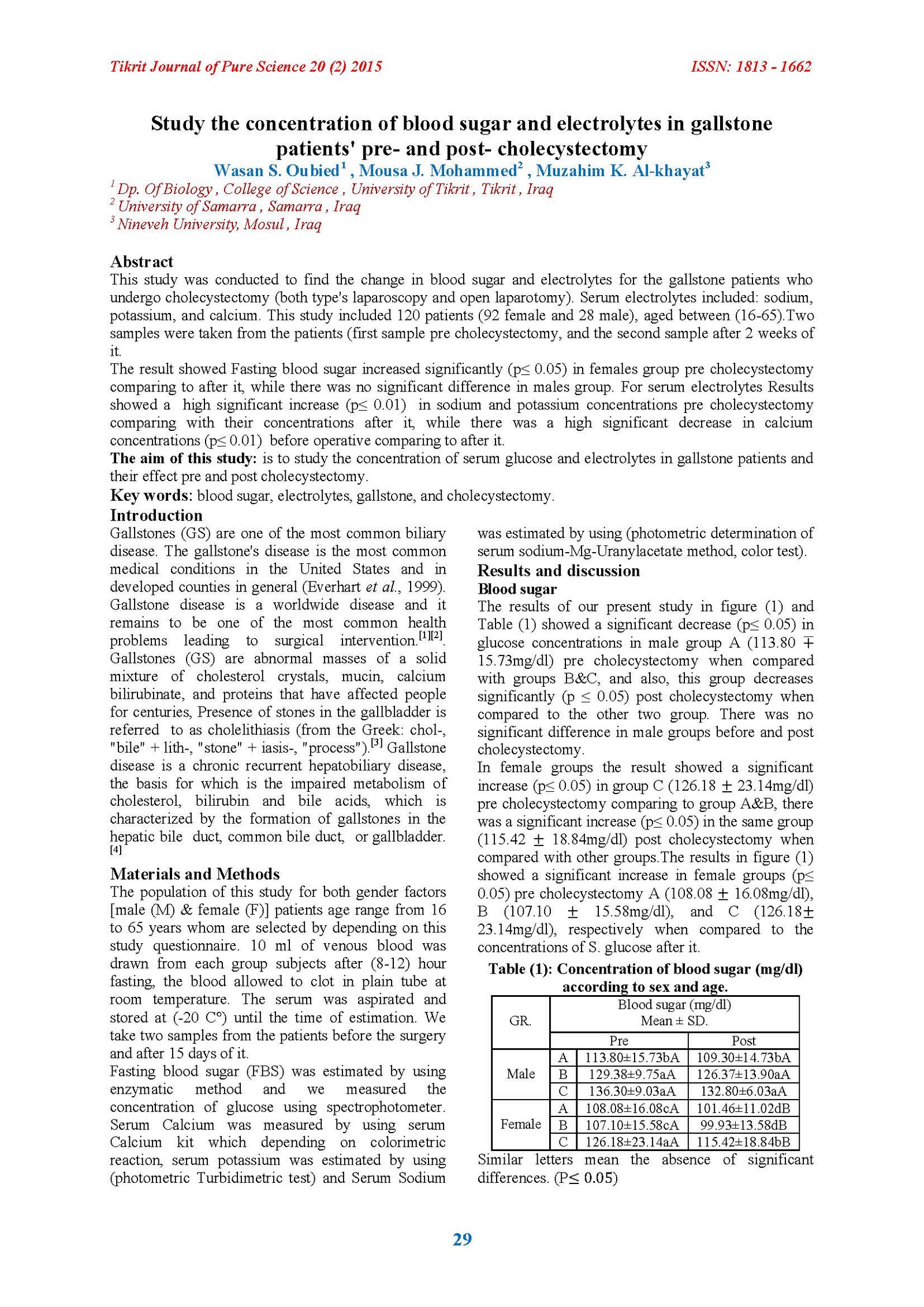Study the concentration of blood sugar and electrolytes in gallstone patients' pre- and post- cholecystectomy
Main Article Content
Abstract
This study was conducted to find the change in blood sugar and electrolytes for the gallstone patients who undergo cholecystectomy (both type's laparoscopy and open laparotomy). Serum electrolytes included: sodium, potassium, and calcium. This study included 120 patients (92 female and 28 male), aged between (16-65).Two samples were taken from the patients (first sample pre cholecystectomy, and the second sample after 2 weeks of it.
The result showed Fasting blood sugar increased significantly (p≤ 0.05) in females group pre cholecystectomy comparing to after it, while there was no significant difference in males group. For serum electrolytes Results showed a high significant increase (p≤ 0.01) in sodium and potassium concentrations pre cholecystectomy comparing with their concentrations after it, while there was a high significant decrease in calcium concentrations (p≤ 0.01) before operative comparing to after it.
Article Details

This work is licensed under a Creative Commons Attribution 4.0 International License.
Tikrit Journal of Pure Science is licensed under the Creative Commons Attribution 4.0 International License, which allows users to copy, create extracts, abstracts, and new works from the article, alter and revise the article, and make commercial use of the article (including reuse and/or resale of the article by commercial entities), provided the user gives appropriate credit (with a link to the formal publication through the relevant DOI), provides a link to the license, indicates if changes were made, and the licensor is not represented as endorsing the use made of the work. The authors hold the copyright for their published work on the Tikrit J. Pure Sci. website, while Tikrit J. Pure Sci. is responsible for appreciate citation of their work, which is released under CC-BY-4.0, enabling the unrestricted use, distribution, and reproduction of an article in any medium, provided that the original work is properly cited.
References
1. Assefa G. Epidemiology of gallstone disease in Gondar University Hospital, as seen in the department of radiology. Ethiop.J.Health Dev. 2008; 22 (2):206-211.
2. Schirmer BD, Winters KL, Edlich RF. Cholelithiasis and cholecystitis. J. Long Term Eff. Med. Implants. 2005; 15(3):329-338.
3. Leonard V. Crowley (Eds): An introduction to Human Disease. 9th ed. (2010), Jones & Bartlett Publishers, Canada. pp: 539-563.
4. Vasiliy Ivanovich Reshetnyak: Concept of the pathogenesis and treatment of cholelithiasis. World J. Hepatol (2012); 4(2): 18-34.
5. Kim SS., Lee JG, Kim DW, Kim BH, Jeon YK, Kim MR, et al., Insulin resistance as a risk factor for gallbladder stone formation in Korean postmenopausal women. Korean J. Intern. Med. (2011); 26:285-93.
6. Neha J., G. S., Iqbal Ali, Gaurav Sali, Raghuveer Reddy. Effect of cholelithiasis and cholecystectomy on serum lipids and blood glucose parameters. (2013) Volume: 3/Issue: 2 P: 97-101.
7. Virupaksha HS., Rangaswamy M, Deepa K, Goud BK, Nayal B. Correlation of serum lipids and glucose tolerance test in cholelithiasis. Int. J. Pharm. Biosci. (2011); 2:224-8.
8. Tawfiq B. Fadil. Estimating of some biochemical parameters in patient with gallstone. Collage of medicine. Tikrit University. (2011). Salahaddin. Iraq. 25-30.
9. Wang HH., Portincasa P., Wang DQ. Molecular pathophysiology and physical chemistry of cholesterol gallstones. Front Biosci. (2008); 13:401-423.
10. Shaffer EA. Gallstone disease: Epidemiology of gallbladder stone disease. Best Pract. Res. Clin. Gastroenterol. (2006); 20(6): 981-996.
11. Jalaja D. Kumari and B. Sri Hari Krishna. Role of Body Mass Index, Physical Activity and Nutrients in Cholelithiasis in Guntur, J. Hum. Ecol. (2010); 31(3): 151-155.
12. Alan R. G.: Nutritional Approaches to Prevention and Treatment of Gallstones. Altern. Med. Rev. (2009); 14(3):258-267.
13. Kayacetin E., Kisakol G, Kaya A, Akpinar Z. Real- time sonography for screening of gallbladder
motility in diabetic patients: Relation tozautomatic and peripheral neuropathy. Neuroendocrioology Letters. (2003); 24 (2):73-76.
14. Méndez-Sánchez N., Chavez-Tapia NC, Motola-Kuba D, Sanchez-Lara K, Ponciano-Rodríguez G, Baptista H, Metabolic syndrome as a risk factor for gallstone disease. World J. Gastroenterol. (2005); 11:1653-7.
15. Nakeeb A., Comuzzie AG, Al-Azzawi H, Sonnenberg GE, Kissebah AH, Pitt HA. Insulin resistance causes human gallbladder dysmotility. J. Gastrointest Surg. (2006); 10(7):940-948.
16. Naseem, A. Ch., Fatehuddin Khand, Ali Mohammad Soomro. Comparison of serum calcium, copper and iron levels in serum samples from gallstone patients and control subjects .Pak. J. Med. Sci. (2012) 28 (4).
17. Chandran, P., G., P. and Pundir, C. S. Correlation between chemical component of biliary calculi and bile & sera and bile of gallstone patients. Indian J. Clin. Biochem. (2005). 20.81.
18. Kleiner, O. J. Ramesh, Mahmoud H., Beny C., Keren K., Chen Levi, Boris P., Robert S. Marks, Jacov M., Zahavi C. and Shaul M. A comparative study of gallstones from children and adults using FTIR spectroscopy and fluorescence microscopy. BMC Gastroenterology. (2002).2:3.
19. Ashok M., Nageshwar R. D, Jayanthi V, Kalkura SN, Vijayan V, Gokulakrishnan S, Nair KG. Regional differences in constituents of gall stones. Trop Gastroenterol. (2005): 26: 73-5.
20. Lindseth, G. and Bird-Baker, MY. Risk factors for cholelithiasis in pregnancy. Bird-Baker. Res. Nurs. Health. (2004). 27, (6) 382.
21. Nazmi TO., Korkmaz F., Birchal J. PIXE analysis of gallstones from Turkish patients. Instruments and Methods in Physics Research, (2006) 562: 1054-1056.
22. Kumar D., Garg PK., Tandon RK. Clinical and biochemical comparative study of different types of common bile duct stones. Ind. J. Gastroenterol. (2001); 20: 187-90.
23. Worthington HV. Hunt LP, McCloy RF, Maclennan I,Braganza JM. A. pilot study of antioxidant intake in patients with cholesterol gallstones. Nutrition. (1997); 13: 118–27.
